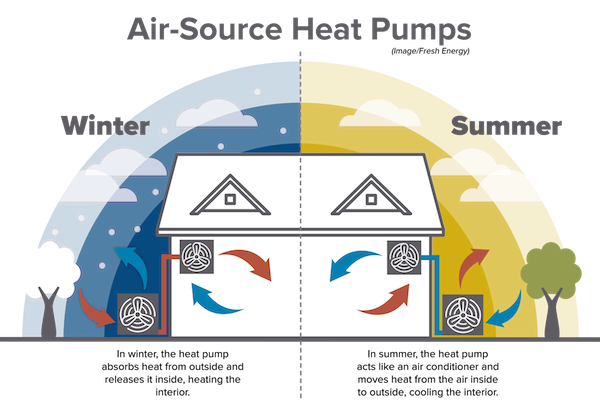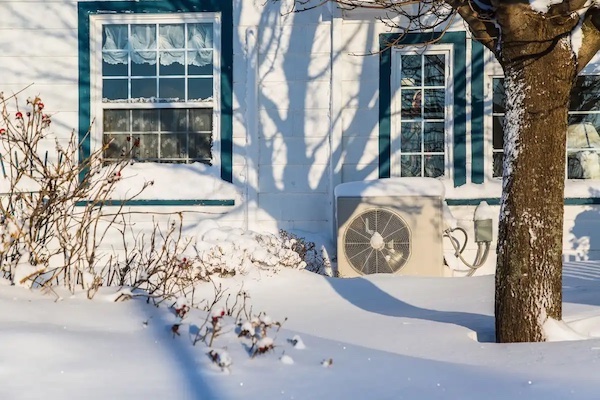25 May 2022, 21:21
by
Matt Hempy
You may have not thought about it, but the way you heat and cool your home is also a great way to reduce your carbon footprint, help the earth, and your wallet. Often overlooked, the heat pump is a great solution to reducing our carbon footprint in the United States and around the world. While the name may appear misleading, heat pumps actually heat and cool your home. They are electric, energy-efficient, and can provide comfort in your home with evenly distributed temperatures.
HOW HEAT PUMPS WORK
The science of heat pumps is simple. Heat pumps take heat from one place and move it to another. When it is warm outside, heat pumps transfer heat from inside your home, to outdoors. When it is cold outside, heat pumps move heat from the outdoors and transfer it into your home. Heat pumps don’t generate electrical energy but transfer heat from place to place, making them efficient tools. Modern boilers operate around 90-95% efficiency, while heat pumps can achieve 300-400% efficiency, delivering much more energy than they consume. Of course, there are more moving pieces of how heat pumps work, but these efficient and green systems don’t receive the positive attention they deserve.

Graphic Source Fresh Energy
HOW MOST US HOMES ARE HEATED AND COOLED:
Natural gas is the principal heating fuel for 47% of U.S. homes, according to the 2015 Residential Energy Consumption Survey. Of the four main U.S. regions (Midwest, South, West, and Northeast), the South is the only region where natural gas is not the main heating fuel choice, according to US Census Bureau Data. Natural gas can power a boiler, which heats water and cycles the heat through radiators, or a furnace, which heats and transfers air through vents. According to the U.S. Energy Information Administration, only 1 percent of US homes utilize electric heat pumps.
.png)
Courtesy of US Energy Info. Admin.
CLIMATE CHANGE ACTION: THE IMPORTANCE OF ELECTRIC-POWERED SYSTEMS AND APPLIANCES
As a climate change solution, heat pumps are a huge step in electrifying the nation, something that is necessary to reach our 2030 goal of reducing US emissions by 50-52% from 2005 levels. With over 140 million homes in the country, 20% of all United States’ greenhouse gas (GHG) emissions come from heating, cooling, and powering households. If this amount of emissions were measured as a country, it would fall between the European Union and Russian total GHG emissions, as the fifth-largest emitter in the world. Electric systems like heat pumps can help reduce these statistics. Only 20% of the US power grid comes from renewable energy, but as this increases, it is important to continue to electrify our homes.
OTHER BENEFITS OF HEAT PUMPS:
Heat pumps have higher installation costs than furnaces or boilers, but depending on where you live, can save you money as they require less maintenance. Switching to a heat pump can save you $1000/year according to the US Dept. of Energy. Likewise, there are federal tax credits and rebates that are available if you purchase a heat pump. Since they are electric-powered and fitted with air-cleaning filters, heat pumps have no risk of gas leaks and provide very clean air. Being heat and cooling systems, heat pumps simplify your home’s climate needs and are a tangible way that you can help fight against the climate crisis. Amy Boyd, the director of policy for the Acadia Center says that “A heat pump is probably the biggest thing that consumers can do to help fight the climate crisis”.
DIFFERENT TYPES OF HEAT PUMPS:
Engineers are constantly developing new and improved models of heat pumps, but in this article, we will focus on the two main types of heat pumps: Air source and ground source.
Air source heat pumps move heat from the outdoor air when your home needs to be warmer, and when your home needs to cool down, they take heat from inside and expel it outdoors. Air source pumps operate through a unit outside your house, typically placed in the front or back yard or garden, connected through pipes or vents to unit/s inside your house. Heat pumps have been used in all climates around the United States for years, even in very cold areas like the Alaskan tundra. Air source heat pumps are constantly improving to heat and cool homes in any climate. The two main types of air source heat pumps are ductless or ducted.
Ducted heat pumps transfer the heat through ducts within your home, and vents placed in your walls. If your home already has an existing duct system then it is a good idea to utilize this and install a ducted system. It is important to ensure that your duct system is properly insulated and doesn’t contain leaks, so your heat pump can use these existing pathways with optimal efficiency. Ductless systems also have two components, an indoor air-handling unit and an outdoor compressor/condenser, connected through a power cable. Ductless systems are great retro-fit add-ons, and only require a small hole in the wall to connect the two units. Ductless systems are generally more expensive but offer quicker and simpler installation. For more information on air source heat pumps visit this site.
.jpg)
Ductless air source heat pump system. Courtesy of L&H
.jpg)
Ducted air source heat pump system. Courtesy of Take Control and Save
Ground source heat pumps draw their energy from groundwater or earth around a home. Temperatures underneath the earth are more stable than the air, making ground source heat pumps more reliable and protected from harsh weather. Ground source systems have an indoor component connected through pipes to an underground system that extracts the heat. They are more expensive and require more space than air source pumps but have a longer lifespan. Depending on the climate in which you live, these heat pumps can reduce your energy use by 30-60%, and can save you 65% in energy costs compared with electric furnaces. For additional information on ground source heat pumps, visit this site.
.jpg)
Ground source heat pump sourcing energy from the earth. Courtesy of Vitt Heating
BEST HEAT PUMP FOR YOUR CLIMATE
For most people, an air source heat pump is the most viable option. They require less space, are more affordable, and operate in the widest variety of climates. Air source technology has improved dramatically over the last few years and the disparity in efficiency between ground and air source systems is decreasing. Given their versatility and cheaper installation costs, they are a great choice for many. If you are retrofitting a home, ductless air source heat pumps are smart because of the ease of installation.
For those of you with larger properties, in more extreme climates, or looking to install heat pumps in an industrial building, a ground source may be the correct choice for you. However, they will require more space, higher installation costs, and nearby groundwater, if that is your energy source. The first step is to take a look at your home, your budget, and the climate you live in to make a smart choice. There are a few other factors to consider when purchasing a heat pump.
HEAT PUMPS IN COLD CLIMATES
For those of you who live in areas that experience extremely cold temperatures, you can rest assured that heat pump technology has improved so much that although your yard may be covered in snow and ice, heat pumps can still create a warm and comfortable environment in your home. There are a lot of misconceptions around heat pumps, with their inability to operate in extreme temperatures, but they are now able to into temperatures of around -10 degrees Fahrenheit. However, if just a heat pump won’t suffice entirely on its own for your climate, you can consider a dual-heat or hybrid-heat system to combine the functionality of a heat pump and gas furnace. It’s actually pretty similar to using a hybrid car. In this case, you are only using your fossil fuel-powered system on certain days, helping to decrease your carbon footprint overall.

A Heat pump in winter. Courtesy of Carbon Switch
SEEK A PROFESSIONAL TO GET THE RIGHT ONE
Every home is different and a professional is necessary to help you select the proper type and size heat pump for your specific home. It is important for the heat pump size to be correct so you can maximize your energy efficiency and savings. Certain rebates will only be offered if the system has a certain performance/efficiency standard. Well-known manufacturers like Daikin, LG HVAC, and Trane have partnerships with contractors, who have experience with installing their products. Research what you are looking for and begin by reaching out to a trusted manufacturer. Check out Senior Director for 100% Renewable Energy Johanna Neumann for a better look at the installation process. Neumann has a great play-by-play of her home's heat pump transition.
MAKE THE SWITCH FOR A BETTER WORLD
The reality of climate change can be daunting, but our individual decisions have the power to help in big ways. Any time a homeowner decides to install a heat pump or switch their old gas or oil powered system for one, they are making a decision that benefits the climate for 15, 20, or 30+ years. Updating your old furnace or boiler for a new one of the same incurs locked-in emissions, emissions that will occur until that system fails years down the road. Transitioning to a heat pump may seem like a huge change, but this isn’t like paper straws in your smoothies. Heat pumps are beneficial for the earth and won’t leave you frustrated. Nothing against plastic-straw alternatives; but paper just doesn’t cut it. If heat pumps are adopted on a large scale around the U.S. then we should see some really positive impacts. The technology exists and the solution has arrived to heat and cool our homes’ sustainability. It is now our responsibility to make the switch.
Back to news


.png)
.jpg)
.jpg)
.jpg)
